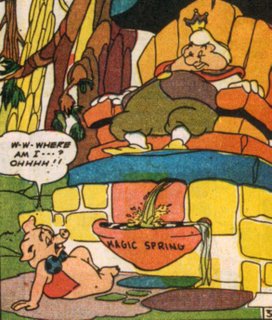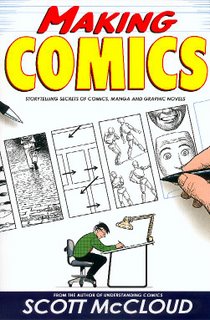I wrote this in 1980 and it appeared in The Comics Journal #63 in the spring of 1981. I'm reprinting it because I find it interesting that some things have changed signficantly and other things not at all. I'll be coming back to this in a future entry to talk about how things look 25 years after this article appeared.
It is interesting that in the period when comics have spawned a large, enthusiastic, and prolific fandom, animation has done no such thing. Perhaps super-heroes have a more direct link to one's wish fulfillment than Bugs Bunny, or perhaps it's easier to write and draw your own comic (even a bad one) than it is to animate a cartoon. But I think the real reason is the relative health of the comics industry and the ease with which young talent can enter and rise to a position where it can express itself.
It is now an accepted procedure for fan artists and writers to enter professional comics. If they are unable to or don't choose to, there is the world of underground comics, ground level comics, and fanzines, all of which provide an outlet for talent and an audience to appreciate it. The young animation fan today faces a very different story. Animation's fan press consists entirely of
Funnyworld and
Mindrot. There is not a single professional animation trade publication in the U.S. The unions on each coast publish monthly newsletters, with an obviously restricted point of view, and regular film trade publications cover animation only sporadically and never very perceptively.
So the young animation fan is disadvantaged in reading about his field, and the young animator is more disadvantaged in displaying his work. Where an underground comic may not sell a large number of copies, it costs only a dollar or two and is available to anyone anywhere in the country. Films or videotapes cannot be sold as cheaply, and film festivals are not as widespread as they might be. The young animator must labor to produce the film and then must labor for it to get any kind of exhibition.
He we come to a curious parting of the ways between comics and animation. Someone like Robert Crumb or Wendy Pini can develop a strong following and an economic success outside comics' mainstream publishing. But they will be read by the same people who might read
Spider-Man or
Green Lantern. There are some independent animators who have been able to build critical reputations and get distribution for their films (George Griffin, Kathy Rose, Dennie Pies, etc.), but their audience is vastly different from the one that watches Bugs Bunny and these artists prefer it that way. They have a fine arts orientation, often taking their aesthetic from painting or graphic design, rather than a narrative orientation, where they would tell a conventional story.
Where does this leave the young animator who admires the animation of the '30s, '40s and '50s? In a very tough spot, it appears. The majority of animation in the U.S. is for Saturday morning cartoons. By anyone's standards, they are a pale shadow of what American animation once was. It is, however, the easiest entry point into the business. Other production consists of feature films, TV specials, and commercials. Unfortunately, these have been tainted by the low standards set by Saturday morning animation. Good animation is not a water faucet you can turn on or off at will. Full animation is incredibly hard to do and takes years of practice. If you don't get that practice to begin with, or you avoid practice too long, you cannot animate well. America is filled with animators who have never learned their craft and veterans who have not practiced enough in the last 20 to 30 years.
In the '50s and early '60s, before made-for-television animation, the only cartoons shown were those made for theaters. Watching TV in New York as a child, I saw animation from many American studios: Disney, Warners, MGM, Lantz, Terry, Fleischer, Famous, and even relatively obscure studios like Iwerks, Van Beuren, and Mintz. I didn't know it at the time, but I was getting a crash course in American animation; how the studios differed and how each studio changed over the years. These cartoons inpired a whole generation of animation fans, many of whom have tried to break into the business and learn the type of animation that America excelled at. But the opportunities just aren't there. Jim Steranko could read
Captain America as a boy and then do an excellent version of the character as an adult. There are no young animators who are doing excellent versions of Mickey Mouse, Bugs Bunny, or their equivalents.
If you eliminate the Disney studio, always a special case, there are damned few places an animator can flourish. I know several young people who worked on
Raggedy Ann and Andy in New York in 1976. Seven were particularly serious about animation and all were assistant animators or inbetweeners. Of the seven, one is now working in London. Five of the seven tried California and three of those five have tried New York again, and have also worked in or gotten work from Canada. One is beginning to produce, but is not yet able to produce personal films. I myself have worked in New York and the Midwest. The common goal was initially to animate; to shape a scene, take a character and bring it to life so that it could entertain an audience. But when we became animators, the real problems became evident. You need a well-thought-out film and an interesting character before an animator can really go to work. And as bad as American animation has become, the films that house that animation are much worse. People have developed such low expectations that a dull cartoon does not surprise them. And those expectations are constantly reinforced.
Animation, like comics, is based on an emotional appeal. The first comic books may have been crude, but their appeal was undeniable. The animated film, no matter how crude, must examine itself and try to figure out what makes it appealing. And finding that, it must then seek to polish and refine it if animation is ever to gain its old ability to hold an audience. In the meantime, young animators are struggling day by day to learn their craft and to find more interesting projects. If the project on their their board now is dull and crude, I hope that they can learn from it so when an opportunity arises, they can overcome all the cynicism and neglect that has attached itself to animation and reach an audience.
 I'm writing about this film not only because I thought it was one of the best I saw at the Ottawa festival, but also because I think the film is a metaphor for Mike Sporn's career and what animation needs to be.
I'm writing about this film not only because I thought it was one of the best I saw at the Ottawa festival, but also because I think the film is a metaphor for Mike Sporn's career and what animation needs to be.















